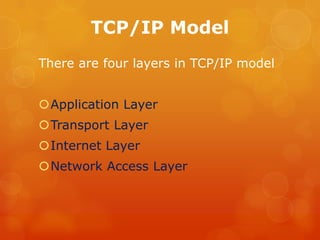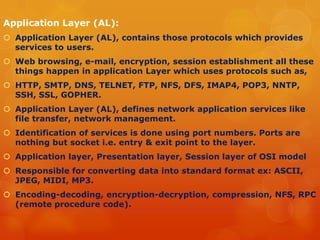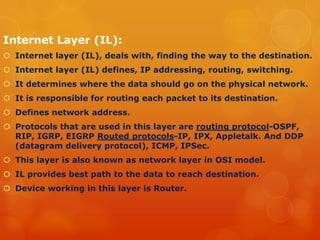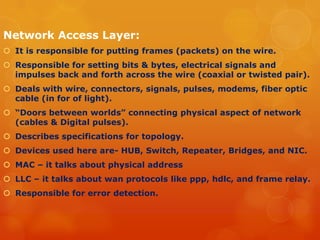TCP/IP Model
- 1. TCP/IP ModelThere are four layers in TCP/IP modelApplication LayerTransport LayerInternet LayerNetwork Access Layer
- 2. Application Layer (AL):Application Layer (AL), contains those protocols which provides services to users.Web browsing, e-mail, encryption, session establishment all these things happen in application Layer which uses protocols such as,HTTP, SMTP, DNS, TELNET, FTP, NFS, DFS, IMAP4, POP3, NNTP, SSH, SSL, GOPHER.Application Layer (AL), defines network application services like file transfer, network management.Identification of services is done using port numbers. Ports are nothing but socket i.e. entry & exit point to the layer.Application layer, Presentation layer, Session layer of OSI modelResponsible for converting data into standard format ex: ASCII, JPEG, MIDI, MP3.Encoding-decoding, encryption-decryption, compression, NFS, RPC (remote procedure code).
- 3. Transport Layer (TL):Two important protocols are used in Transport layer (TL). They are TCP and UDPTransport layer (TL), deals with actual manipulation of data and prepares it for delivery through network.If data is too large for the single frame, then TL breaks it into smaller pieces and assigns sequence number.It ensures that all the data is received in the right order than it was sent.TL is responsible for ensuring data is sent and received successfully.TL is responsible for verifying delivery of packets.Identification services, sequencing, flow control, error correction, segmentation, reassembling is done here.
- 4. Internet Layer (IL):Internet layer (IL), deals with, finding the way to the destination.Internet layer (IL) defines, IP addressing, routing, switching.It determines where the data should go on the physical network.It is responsible for routing each packet to its destination.Defines network address.Protocols that are used in this layer are routing protocol-OSPF, RIP, IGRP, EIGRP Routed protocols-IP, IPX, Appletalk. And DDP (datagram delivery protocol), ICMP, IPSec.This layer is also known as network layer in OSI model.IL provides best path to the data to reach destination.Device working in this layer is Router.
- 5. Network Access Layer:It is responsible for putting frames (packets) on the wire.Responsible for setting bits & bytes, electrical signals and impulses back and forth across the wire (coaxial or twisted pair).Deals with wire, connectors, signals, pulses, modems, fiber optic cable (in for of light).âDoors between worldsâ connecting physical aspect of network (cables & Digital pulses).Describes specifications for topology.Devices used here are- HUB, Switch, Repeater, Bridges, and NIC.MAC â it talks about physical addressLLC â it talks about wan protocols like ppp, hdlc, and frame relay.Responsible for error detection.




